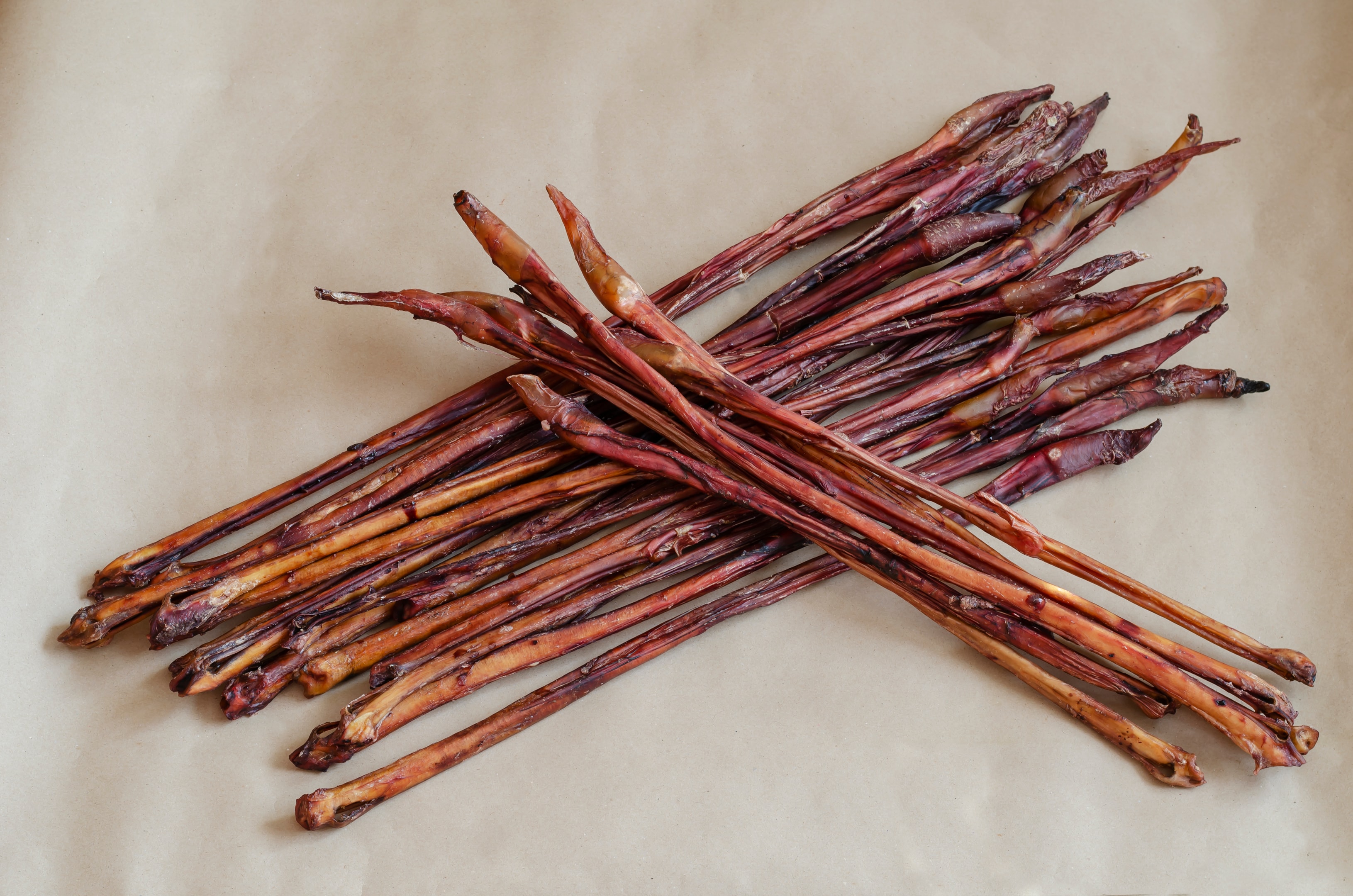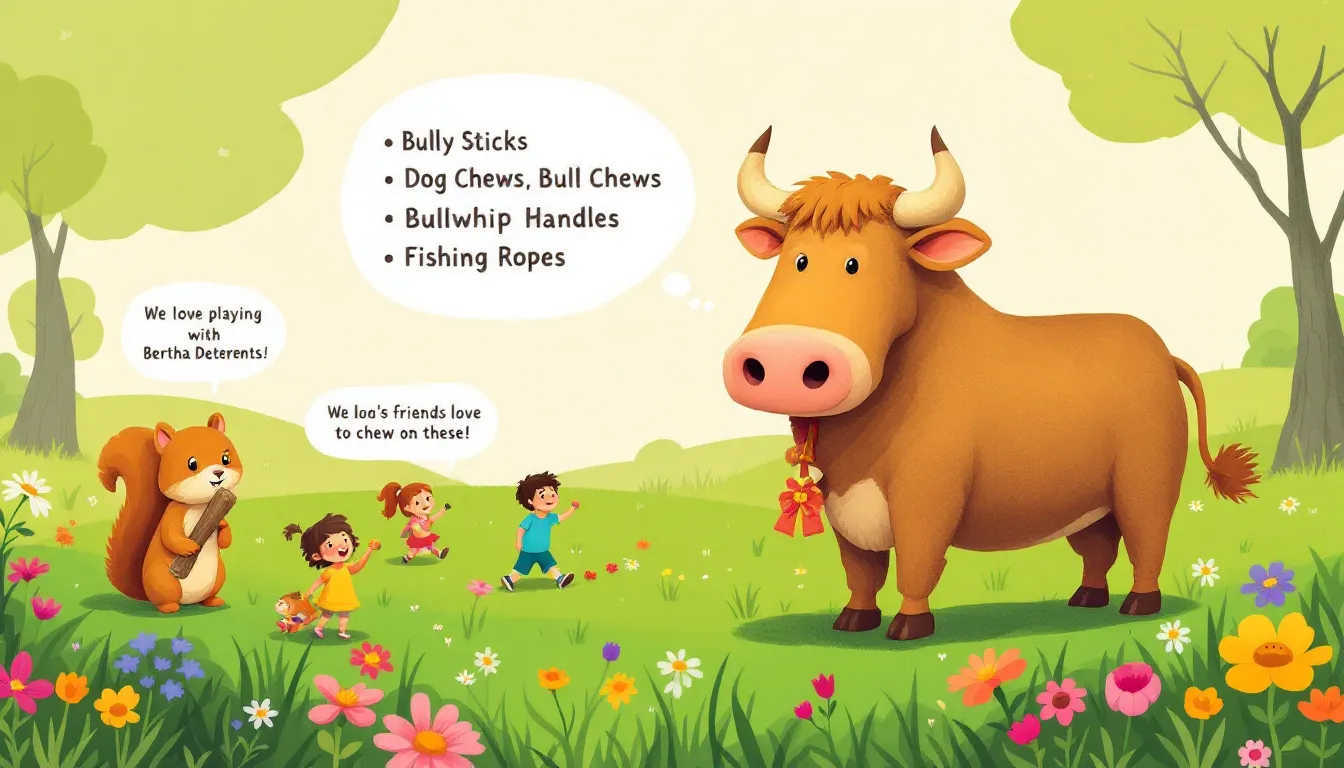Comprehensive Pizzle Definition: Understanding the Term and Its Uses
Posted by Greg C. on Feb 17, 2025
Comprehensive Pizzle Definition & Uses
A pizzle is the penis of a bull. This article explains its PIZZLE DEFINITION, origins, anatomy, and how it’s used today, including as dog treats called bully sticks.
Key Takeaways
-
The word ‘pizzle’ originates from Middle Low German and has been used since the 15th century to refer to the penis of a bull.
-
Historically, ancient cultures utilized bull pizzles for various purposes, including flogging instruments and walking sticks. They then became popular as dog treats, known as bully sticks.
-
Bully sticks offer health benefits for dogs, being high in protein and helping with dental hygiene, while ethical sourcing and production processes are increasingly important to consumers.
Origin of the Word "Pizzle"
The term “pizzle” originates in the Middle Low German pēs word ‘peel’ and is connected to the Dutch ‘pees,’ meaning sinew. This etymological journey doesn’t stop there; it also has links to the Flemish pēzel, a diminutive form of ‘pees.’ These linguistic connections highlight the anatomical function and structure of the pizzle, indicating its importance in earlier times and its Germanic origin. One might compare low German pēsel and middle Dutch to understand these connections better.
Tracing the history of the word “pizzle,” it’s fascinating to note that its first known usage dates back to the 15th century. By the 1520s, “pizzle” was already recognized, demonstrating its longstanding presence in our lexicon. The word itself might sound quaint today, but its historical roots are deeply embedded in the language of anatomy and animal husbandry.
The origin of “pizzle” lays the groundwork for examining its anatomical and cultural significance. Observe how this term has evolved from a simple anatomical reference to one with diverse applications and meanings.
What is a Pizzle?

A pizzle, in simple terms, is the penis of a bull, a definition tracing back to the Old Low German root ‘*Pisa.’ The bull’s pizzle, or penis, is a remarkable structure featuring a distinctive sigmoid flexure that allows it to remain retracted when not in use.
Anatomically, the bull’s penis includes the glans penis at its tip, which is richly innervated and crucial during copulation. This intricate structure is composed mainly of spongy tissue that engorges with blood during arousal, leading to an erection essential for the act of mating. These details highlight the biological significance of the pizzle beyond its more familiar modern uses, including the bull penis.
This foundational knowledge explores the historical and modern uses of the bull’s pizzle and clarifies why it has been valued across cultures and eras.
Historical Uses of Bull Pizzles
Bull pizzles have a long history of being used as flogging instruments, with records dating back to at least 1523. These instruments were particularly noted in the 16th century, where they were employed for discipline and punishment. The use of bull pizzles as whips continued into more modern times, including during World War II when paramilitary groups used them for discipline against civilians.
But bull pizzles' historical uses don’t stop there. In ancient cultures, particularly in Ancient Egypt, bull pizzles were crafted into walking sticks. This practice highlights the pizzle's versatility and utility, transforming a biological organ into a functional and symbolic item.
These historical contexts help us understand the modern uses of bull pizzles, particularly as dog treats and bulls.
Modern Uses of Bull's Pizzle

Today, the most common use of bull pizzles is in dog treats, known as bully sticks. Humans do not typically consume these treats, but they serve as nutritious and enjoyable chews for dogs. The popularity of bully sticks has surged due to their dental and nutritional benefits. They provide essential protein and amino acids supporting a dog’s health.
Bully sticks come in various forms, including straight, curly, and flavored options, catering to the diverse preferences of our canine friends. They can keep dogs mentally stimulated and physically engaged, preventing boredom-related behavior problems. This modern use underscores the practical benefits of bull pizzles in pet care.
Moreover, many consumers prioritize brands emphasizing ethical sourcing and animal welfare standards when producing bully sticks. This demand for transparency and ethical considerations aligns with broader consumer preferences for responsibly sourced products.
Comparing Pizzle to Other Animal Parts
When it comes to natural chews for pets, bull pizzles are often compared to other options like bones and tendons. Pizzles are more durable than tendons but may not be as long-lasting as certain types of bones. However, bull pizzles are considered safer than some rawhide options, though all chews should be monitored for choking hazards.
Nutritionally, bull pizzles provide protein and essential nutrients, making them a beneficial treat compared to some bones, which may have limited nutritional value. This comparison highlights the advantages of choosing bully sticks for pet owners looking to provide a healthy and safe chew for their dogs.
These comparisons help pet owners choose the best treats for their furry friends, considering both safety and nutritional benefits.
Cultural References and Slang
In slang, “pizzle” commonly refers to the penis of an animal, particularly a bull. This usage has been prevalent in various cultures and is often employed in a humorous or colloquial context. The term “pizzle” also denotes a whip made from the skin of a bull’s penis, used historically in different cultures for discipline and punishment.
These cultural references and slang usages add a layer of complexity to the term “pizzle,” showing how it has been adapted and used in different contexts over time. The pizzle’s journey through history, from anatomical references to punishment tools, is fascinating and multifaceted.
Transitioning to making bully sticks, it’s notable how an object with such diverse historical and cultural significance has found a new life in pet care.
The Process of Making Bully Sticks
Making bully sticks begins with sourcing the bull’s pizzle, which is thoroughly cleaned to ensure hygiene. After washing, the pizzle is hung vertically to allow any remaining fluids to drain out. This initial preparation is crucial to ensure the final product is safe for dogs.
Next, the pizzle is stretched to achieve a uniform shape and length. This step is essential for creating a consistent product that meets quality standards. The final stage involves drying the pizzle, often through slow roasting, to ensure it is safe and durable for dogs. Some manufacturers may use additional treatments, such as chemicals or irradiation, to eliminate harmful bacteria during production.
Understanding this process gives us a deeper appreciation for the effort and care that goes into making bully sticks, which ensures our pets' safety and enjoyment.
Health Benefits of Bully Sticks for Dogs

Bully sticks are considered single-ingredient treats, primarily composed of muscle tissue from the animal’s penis. Traditional medicine in various cultures has valued bull pizzles for their supposed health benefits, such as high protein intake. These treats provide essential protein and amino acids that support a dog’s muscle development and skin and coat health.
The texture of bully sticks helps remove plaque and tartar, promoting better dental hygiene in dogs. This makes them a safe alternative to other chews, reducing the risks of splintering and digestion issues commonly associated with rawhide.
Highlighting these health benefits underscores why bully sticks have become popular among dog owners seeking nutritious and safe pet treats.
Ethical Considerations
The well-being of animals in the production of pet products, including bull pizzles, raises significant ethical concerns regarding treatment and living conditions. Ethical treatment of animals in production is vital to addressing welfare issues surrounding bull pizzles.
Sustainable sourcing in bull pizzle production minimizes environmental impact and supports responsible animal husbandry. High-quality bully sticks are typically sourced from free-range, grass-fed beef, which promotes better nutrition and humane practices.
Reputable brands ensure the quality of bully sticks by following strict regulations and sourcing high-quality ingredients. These practices align ethical considerations with consumer preferences for responsibly sourced pet products.
Dictionary Definitions
According to Merriam-Webster’s dictionary, “pizzle” is defined as both the penis of an animal and a whip made from a bull’s pizzle. This dual definition highlights the term’s primary meanings associated with animals and as a discipline tool.
The term “pizzle” has several meanings, primarily associated with animals. Understanding these dictionary definitions provides a more precise context for the term’s usage in historical and modern settings.
These definitions solidify our understanding of “pizzle” and its various applications, leading us to the summary and conclusions of our exploration.
Summary
In summary, the bull pizzle is more than just an anatomical term; it has a rich history and diverse applications. From its etymological roots in Middle Low German to its modern use in dog treats, the pizzle has proven to be a versatile and valuable part of the bull. Understanding its historical uses as flogging instruments and walking sticks adds depth to our appreciation of this unique organ.
As we conclude, it’s clear that the bull pizzle’s journey from ancient times to modern pet care highlights its enduring significance. Whether you’re a pet owner or a history enthusiast, the story of the bull pizzle offers a fascinating glimpse into the intersection of biology, culture, and utility.
Frequently Asked Questions
What is a pizzle?
A pizzle is essentially a bull's penis, and it's been used for various purposes throughout history.
Where does the word "pizzle" come from?
The word "pizzle" comes from the Middle Low German 'pesel' and the Dutch 'pees,' which means sinew. Pretty interesting, right?
How are bully sticks made?
Bully sticks are made by cleaning, stretching, and drying the bull's pizzle. The result is a tough, chewy treat that dogs love!
Are bully sticks safe for dogs?
Bully sticks are generally safe for dogs and promote good dental health, making them a great chew option. So go ahead and let your pup enjoy them!
Are there ethical concerns with using bull pizzles?
Bull pizzles raise ethical concerns, mainly regarding animal welfare and sustainable sourcing practices. These factors should be considered when making choices about such products.



